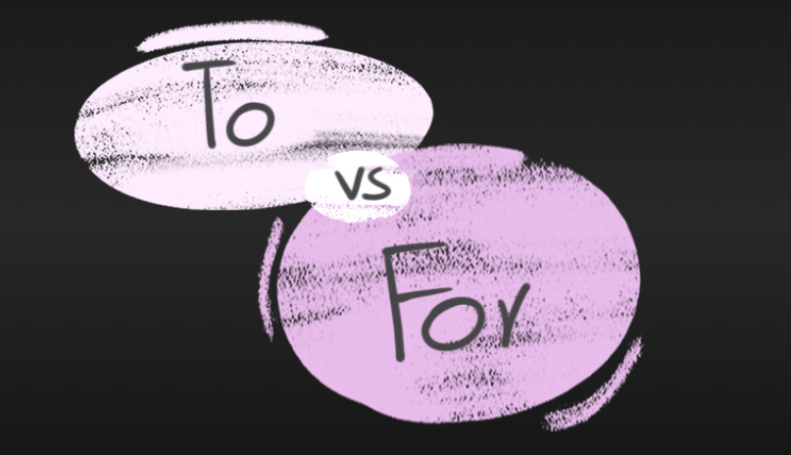Mastering the Usage of 'To' vs 'For' - A Comprehensive Guide
Contents

Did you know that 'to' and 'for' are two of the most commonly used prepositions in the English language? Understanding their difference is essential for clear communication.
When it comes to mastering a language, it's not just about learning vocabulary or memorizing grammar rules - it's about understanding how words function in different contexts. Prepositions play a crucial role in expressing relationships between words, and 'to' and 'for' are no exception.
Whether you're preparing for an important business meeting or simply want to improve your everyday conversations, this guide will provide you with the tools needed to confidently navigate the subtle differences between 'to' and 'for'.
From sentence formation, 'to' vs 'for' examples to practical 'to' vs 'for' exercises, we've got you covered! Let's dive right in!
'To' vs 'For' - What's the Difference?
When it comes to using prepositions in English, one of the most common sources of confusion for learners is the difference between 'to' and 'for'. These two small words play a significant role in sentence formation and can drastically change the meaning of a sentence. In this section, we will explore the basic difference between 'to' and 'for' and provide 'to' vs 'for' examples to help you understand their usage.
'To' vs 'For' Meaning -
To put it simply, 'to' is used to indicate direction or movement towards someone or something.
On the other hand, 'for' is used to express purpose or benefit. Let's delve deeper into these concepts:
1. Using 'to':
Direction: When indicating movement towards a specific destination or recipient, we use 'to'. For example: She sent a letter to her friend.
Indirect Object: We also use 'to' when expressing an action done for someone else's benefit. For example: He offered his help to his colleague.
2. Using 'for':
Purpose: We use 'for' when stating why something is done or intended for a specific purpose. For example: He studied hard for his exams.
Recipient/Beneficiary: When indicating that something is being done or given for someone's benefit, we also use 'for'. For example: They raised money for charity.
Exploring Usage Scenarios - 'To' and 'For'
In this section, we will explore different usage scenarios for both 'to' and 'for', providing you with clear examples and tables to help you grasp their meanings and applications.
Understanding Contexts where we use 'To'
To start off, let's take a look at the various contexts where we commonly use the preposition 'to'. Here is a table comparing different scenarios:
Scenario | Example |
Destination | I am going to London. |
Purpose | She gave me a pen to write with. |
Time | I will be available at my office from Monday to Friday. |
Giving | I gave a gift to my friend. |
Comparison | Her performance in the second round was superior to her first-round effort. |
In addition to the table, here are some examples highlighting typical situations requiring 'to':
When indicating direction: Walk straight ahead and turn left to reach the museum.
When referring to a destination: We planned a trip to Goa during our summer vacation.
When expressing purpose: I need a laptop to complete my online assignments.
When mentioning specific times: The webinar is scheduled from 9 a.m. to 11 a.m.
When giving or transferring something: She handed the package to her colleague.
Understanding Contexts where we use 'For'
Now let's delve into the contexts where 'for' is appropriate. Here is a table presenting different scenarios:
Scenario | Example |
Purpose | I bought a book for studying. |
Duration | He has been waiting for an hour. |
Beneficiary | This gift is for you. |
Exchange | I traded my old phone for a new one. |
Here are some examples illustrating common situations requiring 'for':
When indicating purpose: I bought a new laptop for work purposes.
When referring to a duration of time: He has been practicing guitar for five years.
When mentioning the recipient or beneficiary: I baked a cake for my friend's graduation party.
When explaining the cause or reason: She received a promotion for her hard work and dedication.
When talking about an exchange or trade: They exchanged their contact information for future collaboration.
Now that you have a comprehensive guide on the usage of 'to' versus 'for', let's move on to the next section where we will focus on common mistakes and how to avoid them.

Common Mistakes to Avoid
By being aware some common mistake, you can improve your English language skills and communicate effectively. Let's explore some common mistakes and how to avoid them:
Mistake 1: Confusing the purpose of 'to' and 'for'
The key difference between 'to' and 'for' lies in their purpose. 'To' indicates direction or movement, while 'for' focuses on purpose or benefit.
Example:
Incorrect: She gave a gift to me for thanking me.
Corrected: She gave a gift to me to thank me.
Mistake 2: Using 'to' when expressing duration
When indicating duration, we use 'for,' not 'to.'
Examples:
Incorrect: I have been waiting in line to two hours.
Corrected: I have been waiting in line for two hours.
Mistake 3: Misusing 'to' instead of an infinitive verb
Instead of using 'to' alone, we need an infinitive verb following it.
Examples:
Incorrect: They plan to visit Paris next month, but they don't have enough time to.
Corrected: They plan to visit Paris next month, but they don't have enough time to do so.
By understanding these common mistakes and practicing with various examples, you can enhance your understanding of the correct usage of 'to' vs 'for.'
Mastering 'To' vs 'For' in Your Speech
To truly master the usage of 'to' and 'for' in your speech, you need to be aware of their nuances and practice incorporating them into your everyday conversations. Here are some tips and strategies to help you gain fluency and confidence in using these prepositions effectively:
1) Pay attention to native speakers' usage patterns:
One of the best ways to learn how to use 'to' and 'for' correctly is by observing how native speakers use them in their everyday speech.
Listen to conversations, podcasts, or watch TV shows or movies in English.
Take note of the context in which these prepositions are used and try to understand the underlying meaning.
2) Practice consciously incorporating these prepositions:
Learning a language is all about practice, so make a conscious effort to use 'to' and 'for' in your own conversations.
Start small by focusing on specific phrases or sentences that commonly use these prepositions. For example, you can practice using expressions like 'I'm going to the store' or 'This gift is for you.'
By actively using these prepositions, you'll become more familiar with their correct usage over time.
3) Seek feedback from experienced language instructors at Clapingo:
Getting feedback from experienced language instructors can greatly accelerate your learning process.
They can provide guidance on common mistakes and offer suggestions for improvement.
At Clapingo, our team of expert instructors can help you navigate the complexities of using 'to' and 'for'. They can also provide you with personalised exercises tailored to your specific needs.
Key Takeaways
Now that we have covered the comprehensive guide on mastering the usage of 'to' vs 'for,' it's time to look at the key points discussed throughout this article.
The fundamental difference between 'to' and 'for,' with 'to' indicating direction or destination, and 'for' expressing purpose or intention. The best way to master the usage of 'to' vs 'for' is through practice. Incorporate these words into your everyday conversations, both written and spoken, to become more comfortable using them correctly.
As you continue your journey towards perfecting your English skills, Clapingo is here to provide further guidance and support. Visit Clapingo's website for additional resources, including exercises and examples related to using 'to' vs 'for'.
So why wait? Start incorporating 'to' and 'for' into your sentences today, and watch your English skills thrive with Clapingo's expert guidance and support!
FAQs
1. Which is correct 'used to' or 'used for'?
When deciding between 'used to' and 'used for', it's essential to consider the context. 'Used to' is commonly used when referring to past habits or actions that no longer occur. For example, 'I used to live in London.'
On the other hand, 'used for' indicates the purpose or function of something. For instance, 'This knife is used for cutting vegetables.' Remember, understanding the context will guide you in choosing the correct phrase.
2. What is the difference between 'to me' and 'for me'?
The distinction between 'to me' and 'for me' lies in their underlying meanings.
When someone does something 'to me,' they are acting upon me directly. For example, 'She gave a gift to me.' Conversely, when something is done 'for me,' it means an action has been done on my behalf or for my benefit. For instance, 'He made dinner for me.'
Understanding whether someone is acting directly upon you or performing an action on your behalf will help you differentiate between these phrases.
3. What is the difference between important to and important for?
The difference between 'important to' and 'important for' can be subtle but significant. When we say something is 'important to' us, we are emphasizing its significance or value in relation to our personal feelings or beliefs. For example, 'Family is important to him.'
On the other hand, when we say something is 'important for,' we highlight its importance regarding a particular purpose or outcome. For instance, 'Proper nutrition is important for good health.' By considering whether emphasis lies on personal connection or purpose, you can determine whether to use 'important to' or 'important for'.
4. How can I practice using 'to' vs 'for' correctly?
To improve your mastery of using 'to' vs 'for,' try incorporating them in different contexts. Here are a few exercises to help you practice:
Write sentences where you use both 'to' and 'for' correctly.
Use a dictionary or online resources to find more examples and study their meanings.
Engage in conversations with native English speakers or language partners to get feedback on your usage.
You may want to read
Top 25 Best Spoken English Books for Beginners To Advanced Learners
Comments
Your comment has been submitted